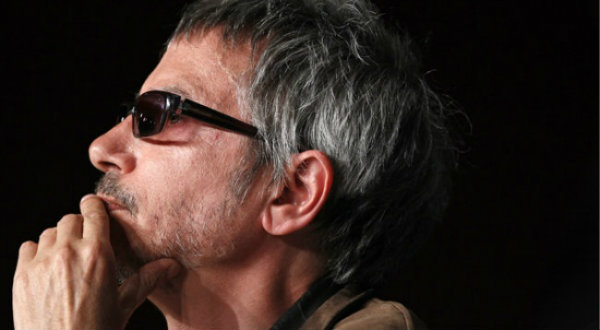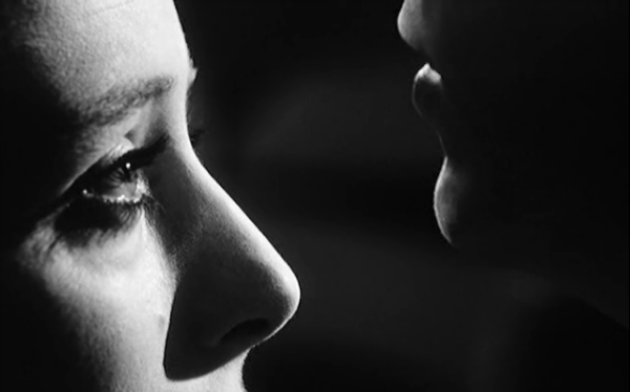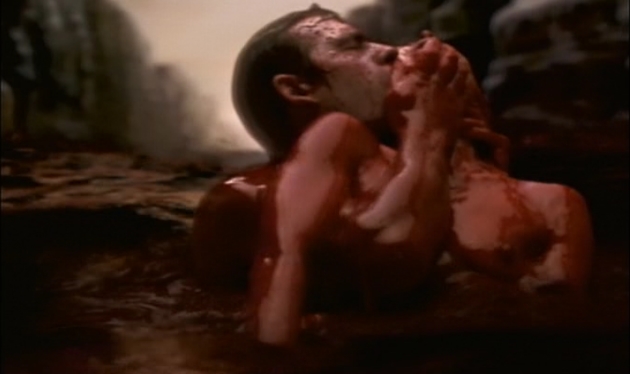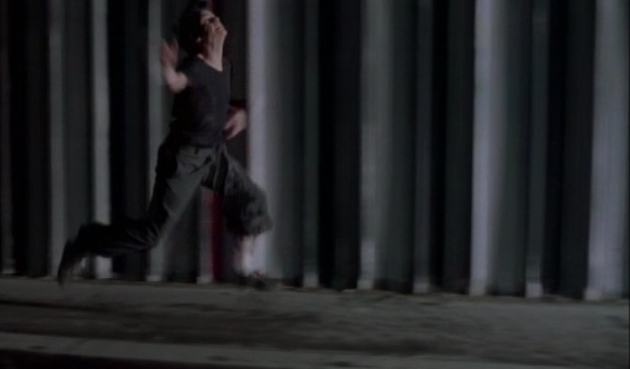The Toronto International Film Festival is about to launch a retrospective celebrating the work of
Holy Motors director Leos Carax, arguably the most important, or at least interesting, working French director. The director's triumphant return to the cinema with
Holy Motors last year after a 13 year absence from feature filmmaking is indeed a cause for celebration, and a perfect opportunity to revisit his singular career. The TIFF retro will include all 5 of Carax's feature films:
Boy Meets Girl,
Mauvais Sang,
Les Amants du Pont Neuf,
Pola X and
Holy Motors.
Over the last 30 years, Carax has made only 5 features, along with a couple of shorts, music videos and some cameo appearances in other directors' films -- Jean-Luc Godard's
King Lear (1987), Lituanian auteur Sharunas Bartas'
A Casa (1995) and Harmony Korine's
Mister Lonely (2007). No prizes for guessing that Carax's career hasn't really been smooth sailing. Once hailed as an heir apparent to French New Wave and extraneously grouped by critics with Jean-Jacques Beineix (
Diva) and Luc Besson (
La Femme Nikita) as one of the leading figures of
Cinema du Look, a pop art movement that relied heavily on style in French cinema scene in the 80s, Carax was one of those bright young talents who fell victim to too much hype too early.
But I'm so very glad that Carax is back in the cinematic realm. Out of years of frustrations and financial hardship, he created something different, energetic and magical without ever losing his deeply personal, self-reflexive filmmaking style. He might not make films about young love that spoke to my heart so dearly anymore, but for the people who are just discovering the works of this shy little Frenchman, this retrospective will provide the window to the world that is just as fantastic as
Holy Motors -- the precious world of being young and in love.
With
Holy Motors topping most of the ScreenAnarchy staff's year-end lists and
TIFF about to embark on its retrospective, now's a perfect time
to take a tour of Carax's romantic, eccentric and always fascinating
body of work, from his features to the music video he directed for former French first lady Carla Bruni. Click through the gallery below to explore.
*The TIFF retrospective will run from August 9 - 15 and will feature Q&A's with Carax himself (a rarity!) at select screenings. For more information, visit the official website.

Tokyo! to Holy Motors
I met Carax for the first time at a Tokyo! screening Q&A. Back then, he was a wary, cynical man who would sign onto any project just for the opportunity to make something, anything. No one was funding him and his new projects had all fallen apart before they even left the ground. It was a disheartening experience to see him in this state.
And yet, his contribution to Tokyo! (2008) was by far the most vivacious, creative segment of the three; Merde, starred his longtime collaborator, Denis Lavant, in the title role of a hideous red-bearded creature in a green suit that emerged from the sewer and wreaked havoc in the streets of Tokyo. When asked if we would see this creature pop up again in other cities, Carax said, "Sure, why not?" This was a good indication of what was to come and gave me hope for the future.
Four years later, after the success of Holy Motors, I found Carax more like a battered old warrior, much wiser and more introspective, and yet with his youthful enthusiasm and love for cinema still intact. He reminisced about his early days when I interviewed him last year at NYFF:
I was kind of a bluff -- I didn't study film, I've never been on a film set before, so when I was asking money for films, I was bluffing. I was proud of being alone. So I paid the price for this pride. It gave me strength but also it made me very isolated in the industry. I can't say it's good or bad but that's my story.
And he gave me his take on cinema:
I was around 16 years old when I discovered this island called cinema where I can see life and death from another perspective, from many different angles. I think every young person should be interested in that island. It's a beautiful place. I haven't made that many films so I don't really consider myself a filmmaker. It's really arrogant for me to say this but I do believe that I live on that island. It's worth living there.

Boy Meets Girl
Nobody could express young love like Carax.
Mirielle (Mirielle Perrier) is unhappy. Her boyfriend Bernard, who lives with her isn't in love with her anymore. Alex (played by Denis Lavant) is heartbroken because his girlfriend dumped him for his best friend. He is signs up for the army. After overhearing Mirielle and her boyfriend fighting through the intercom, Alex starts spying on her. He knows he is destined to fall in love with her. They finally meet and converse at a party hosted by a rich old lady. Alex confesses his love but he is shipping out tomorrow.
With the title cards and themes borrowed from Jean-Luc Godard, Boy Meets Girl (1984) is a stunning debut film, and one that put Carax on the French cinema map. Jean-Yves Escoffier's (who shot all three films in the 'Alex Trilogy') beautiful B&W cinematography is as much a star in this as the lovely, tap dancing Perrier with bad French teeth and all, and of course, the droll troll Lavant. I discover that there are so many great moments and characters in this film as I revisit after more than 15 years. The party and the boy in the subway scenes are particularly delightful.
We long for that special connection with someone. Call it destiny, fate, telepathy, whatever. We fall in love too easily when we are young. Love fades and the new love arrives. Boy Meets Girl is an ode to this learning process.
*This film first introduced Alex, Carax's alter ego. Born Alex Oscar Dupont, Leos Carax is an anagram of his real first and middle name.
Mauvais Sang (Bad Blood)
There is a sexually transmitted disease going around affecting the ones who make love without feelings. Alex (again, played by Denis Lavant) breaks up with his girlfriend (Julie Delpy) and gets recruited by an aging thief, Marc (Michel Piccoli) to steal the serum which holds the cure for the disease. Alex falls for Anna (Juliette Binoche) a young mistress of Marc. They play, sing and hang out together, but Anna is still standing by Marc, the love of her life.
Combining Sci-fi and 'I-just-died-in-your-arms-tonight' noir elements, Mauvais Sang (1986) is an exuberant examination of modern love. Carax makes full use of Lavant's acrobatic physicality in this. This also marks the start of Carax's involvement with the film's star Juliette Binoche.
And now take a look at the most famous scene in the film, set to David Bowie's Modern Love. This wouldn't be the last time Carax exploited Lavant's unique phsyicality.

Les Amants du Pont Neuf (Lovers on the Bridge)
Ever since I saw Les Amants du Pont Neuf (1991) in the early 90s on a bootlegged VHS tape, it had become my favorite film of all time; vibrant images, young Juliette Binoche, manic ugly-man Denis Lavant, amour fou, naïveté... what more can I say?
This unlikely love story between a young homeless man, Alex (Lavant) and a heartbroken painter who's going blind, Michele (Binoche) gets to me every time I watch it. For me, Carax was the only one who successfully articulated the first love with all the trimmings- its selfish nature of being in love, the cause of simultaneous, unimaginable happiness and pain on the screen. I haven't seen anything like that before or since.
The film is ridiculous in its scope -- the most expensive French film ever made at the time. Because Carax couldn't get the permit to shoot on the Pont Neuf bridge (the oldest in Paris), the production crew built a replica of the bridge nearby. But I'll spare you all the well-publicized details here, as they're old news. The night of the Bastille Day celebration in Paris with fireworks and water skiing serves as a backdrop for Michele and Alex to get drunk and dance around like maniacs -- the scene is truly a visual feat. I don't know how Carax managed to pull it all off. A logistical nightmare it was, I'm sure.
I remember the Charlie Rose interview with Binoche for some American fluff she was promoting. When asked about the film and Carax, visibly shaken, she broke down and cried. She and Carax were romantically involved during the filming. Hey, if anyone could make Binoche cry, he/she earns my respect.
Do I really care about the film ending in an upbeat, overly optimistic mood? Not really. Whenever I defend cinema as an artistic medium against literature or music, I usually mention Les Amants du Pont Neuf. The film is really one of a kind -- the energy, the physicality of it will never be duplicated in cinema or in any other form.
Miramax under 'Martin Scorsese Presents' put out the film in late 90s on DVD and a limited theater release. Watching the film on the big screen was truly a blissful experience, to say the least.

Pola X
Fans of Carax's Alex Trilogy, myself included, were deeply disappointed when Carax came back after almost a decade of silence with Pola X (1999), his interpretation of Herman Melville's Pierre: or, The Ambiguities. For those of us who wanted another Les Amant du Pont Neuf, this tale of dark obsession and incest lacked his previous whimsical romanticism. It's not the graphic sex scene (albeit tastefully done and very very dark) that differentiates Pola X as a more mature work. Even though it features some beautiful young actors - the late Guillaume Depardieu at his most dashing, and a dangerous beauty, the late Katherina Golubeva among them, being young is never verbalized or beholden to. A love triangle yes, but for once, it's not about the first love.
Pierre the title character (Depardieu), is a successful writer who is about to get married. He and Lucie are very much in love. Everything is sunny and golden and light. Enter Isabelle (Golubeva), a dark war refugee and claiming to be his half-sister. Pierre, gripped by her magnetism, shuns his wealthy life in the country and his domineering mother (whom he calls sister, Catherine Deneuve), moves into industrial ghetto in Paris, headed and played by enigmatic Sharunas Bartas (looking like a Diehard villain here). Now that Pierre's seen the darker side of life, he realizes that his past writings are trivial fluff. Things get complicated when sickly Lucie decides to move in, just to get closer to Pierre. Short on money, he makes a disastrous TV appearance where he was supposed to talk about his previous book but is instead accused of being an impostor. Then his new dark writings get icy receptions from the publisher. It's all downward spiral.
Shot by Eric Gautier with some seriously underexposed cinematography, Pola X is a decidedly dark, brooding film. Maybe I can see more objectively now, as I liked it a lot more the second time.
Sharunas Bartas acting in Pola X was preceded by Carax's brief cameo appearance in Bartas' A Casa in 1995. Carax publicly admired the Lituanian auteur's work and his muse Golubeva. She and Carax later had a daughter together. Just like any of Carax films, Pola X is a warped self-portrait, reflecting many themes from his life at the time (a tortured artist, misunderstood genius) and his obsession with the late actress.
An interesting tidbit about making of Holy Motors:
Carax again found himself having an impossible time getting a permit for a location when shooting Holy Motors. This time it was for La Samaritaine, a long-abandoned department store in Paris. It is the building overlooking Pont Neuf bridge that was prominently featured in Les Amants du Pont Neuf. In Holy Motors the odd, moving scene involving Kylie Minogue takes place there. After getting rejected by every single bureaucratic official, Carax put in a call to his old collaborator Carla Bruni (wife of then-current president Sarkozy) and she made it happen.
Here is one of two Carla Bruni music videos that Carax directed back at the singer's musical peak: Tout Le Monde
And as a bonus, take a look at Carax's One Minute Short: My Last Minute -- perhaps the Best Quit Smoking ad campaign ever:

Do you feel this content is inappropriate or infringes upon your rights?
Click here to report it, or see our
DMCA policy.

























